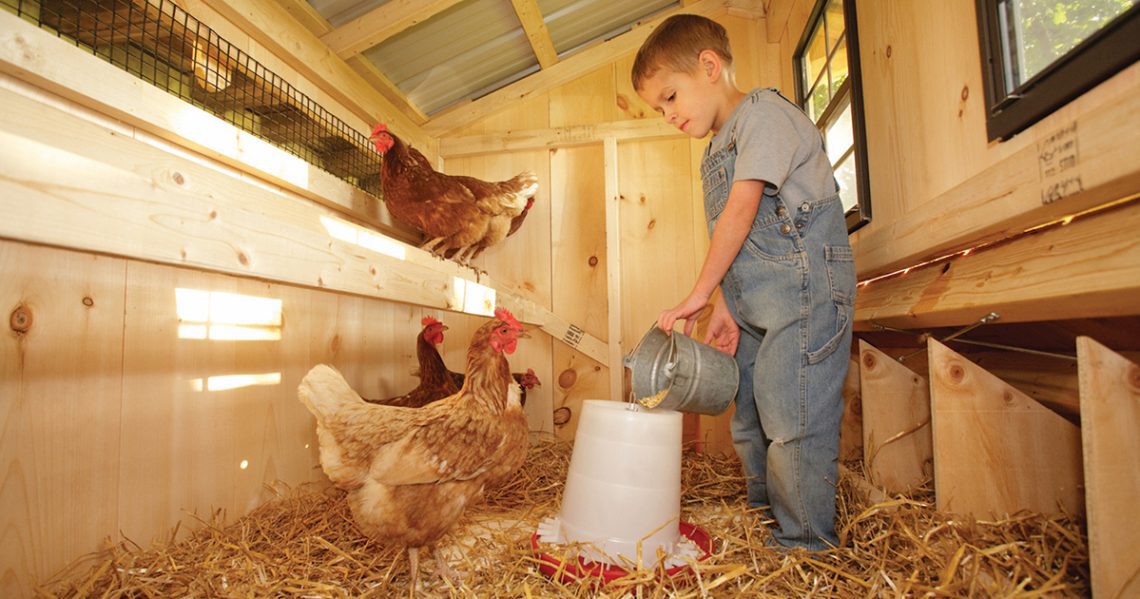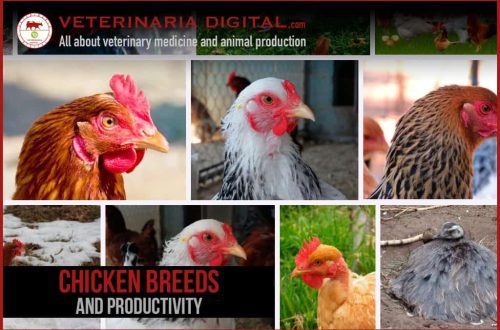
Features and options for keeping chickens at home
Domestic chickens are the most common poultry in the household today. Their popularity is explained by many factors: unpretentiousness in maintenance, high productivity, ease of care. It is difficult to imagine a courtyard in a village where there are no chickens. They provide people with excellent dietary products – eggs and meat.
Contents
Keeping chickens
In the household, you can choose two options for content – cellular and floor. Each of these options has its own advantages and disadvantages.
Outdoor content option implies keeping chickens on the floor on a deep bedding. The main advantage of this method is the ability to create bird walking, free or limited. Chickens with this method are kept indoors. It must be warm, bright, draft-free and dry.
The cellular version of the content is considered more intensive, because the use of industrial space increases significantly. With this option, sanitary and hygienic conditions are increased, as well as easier care for chickens. The disadvantages include a short time to obtain egg productivity. This is due to a sedentary lifestyle.
Minimum conditions for keeping:
- The seating of chickens must be dealt with even during construction, taking into account the fact that per 1 sq. m. fits no more than 2 birds.
- Keeping chickens requires maintaining a constant temperature in the room. It is desirable that it does not fall below 0.
- Chickens need nests to incubate their eggs. As a rule, they are installed in the far corner of the chicken coop, where there is minimal illumination.
- In the chicken coop, you need to install perches, which are most often made of beams and fixed in the middle of the room at a height of about a meter.
- All feeders are installed along the walls of the room: near one side – for dry food, on the other – for drinking, this will make it possible to keep the chicken coop clean.
During the arrangement of additional light, you need follow a number of rules:
- Lighting should not be very bright. This lighting annoys the hens and they may peck at each other.
- Lighting must light up and go out slowly. Sharp flashes introduce the bird into stress. And with frequent stress, laying hens stop producing eggs.
- Lighting should not be directed towards nests or perches. This light also irritates laying hens and you simply cannot see eggs.
The most popular and affordable content option is considered to be outdoor. It is used by the majority of poultry farmers. All that is needed is an insulated room.
At home, it is best to create free access for chickens, this can significantly save on feed and feed the bird only a couple of times a day. Also, chickens in this case are always in motion, this has a great effect on the quality of meat. Eggs from free-range laying hens are healthier and tastier than store-bought eggs.
If there is no free access, then limited to the usual aviary. In this case, the corral is installed right next to the chicken coop so that the chickens can freely enter it. Moreover, laying hens will need to be fully fed and saving will not work.
The whole task of floor maintenance involves the use of a thick layer of bedding in the coop. For this, straw, sawdust, peat, hay, fallen leaves, corn husks are used, the main requirement here is low thermal conductivity. As they get into the layers of litter, they are stirred up and a new one is poured in, without taking out the old one. In winter, the size of the litter must be at least 25 centimeters. It is replaced once a year.
Content in cells
This method of keeping is more popular on large poultry farms. But this system is also used in households. Let’s look at everything first the value of this content.
- It is possible to keep many chickens in a small area.
- Hygiene. Under the cages there is a tray that collects the droppings, and the hens do not have direct contact with it.
- Easier to collect eggs. The eggs, so to speak, collect themselves, they roll along the surface into the chute reserved for them. So, the eggs do not have time to get dirty, and the bird does not have time to crush them.
- Feed savings. Due to the fact that the feeders are located on the outside of the cage, chickens cannot scatter food with their paws.
In addition to the advantages, the content in cells there are some downsides.
- Quite difficult to manufacture and expensive equipment.
- Chickens with this content are inactive, which will certainly affect the quality of the meat.
- With this content, you need to provide a complete diet. Great emphasis should be placed on minerals and vitamins.
The room in which the cage batteries with chickens are located must be draft-free and warm. The microclimate here needs a stable one. We must remember the following: the temperature in the room is 17 degrees with a humidity of 55-65%.
Broilers are perfectly adapted to the conditions of keeping in cages. They just need to restrict movement so that they gain weight faster.
Which content option is best?
If you have a small personal plot, you keep chickens only for food for one family, then, of course, you need to choose the floor option.
If you want to make money on breeding, then to increase the density of planting chickens, it is advisable to choose a cellular version of the content.
How to keep chickens
In order for chickens to have the greatest productivity, all conditions of detention must be met.
An important condition of maintenance is the density of planting. With a very close landing, the chickens will feel uncomfortable, there is a greater risk of various diseases. If the density is low, then the chicken coop space is irrationally used, which is also bad. Optimal seating for birds: per 1 sq. m. 3-4 chickens.
An important condition is also such a condition as the humidity of the air in the chicken coop. The optimal humidity to be maintained is 55-65%. Low humidity threatens to dry out the respiratory tract, which can cause inflammation.
Very high humidity increases the likelihood of developing various diseases. High humidity together with high temperature can cause heat stroke.
In life, low humidity is rare, a more common problem is very high humidity. This can be explained by the fact that chickens emit a fairly large amount of moisture during their life. Excess moisture can be removed with good ventilation.
Lighting mode
This is one of the main conditions of content. The light can be used as a tool for adjusting laying hens. Artificial light in the coop, as a rule, set in winter, when daylight hours are short.
The main reason for the decrease in egg production in winter is the change in daylight hours. In order for egg production to be normal, artificial light is used. It is necessary to use auxiliary lighting very carefully, because laying hens are quite sensitive to this. The optimal daylight hours for these birds are 10-14 hours. You need to increase or decrease it gradually. It is not advised to bring the lighting up to 16 hours or more, the chickens will simply start to overwork and their productivity will decrease.
Light intensity plays an important role. The intensity must be no more than 5 watts. per 1 sq. m.
Coop
Keeping chickens will not work without a chicken coop. In the role of a chicken coop, any insulated room, or a barn, is perfect. It can be built by the chicken breeder himself. You can choose different building materials: blocks, brick, wood. It is important that the chicken coop meets all of the above maintenance requirements.
Choose the size of the chicken coop, you need to take into account the number of birds and the selected content option. The main thing is to correctly equip the chicken coop with all the necessary equipment.
Chicken coop equipment
Drinking bowls
When keeping in a cage, special drinkers must be installed in cages. With the floor version, you can use different types of drinkers. For example, with free range, you can put a simple basin. Indoors, automatic drinkers are more convenient.
Feeders
Much attention should be paid to the design of the installed feeders. The main requirements: the feeder must be easy to wash, be comfortable for chickens and prevent spillage of feed. For wet mash, metal feeders are great. For dry food, it is advisable to choose wooden options.
Perches
This is an important inventory. On perches, chickens like to sleep or just relax. Perches must be installed at the same level, at a level from the floor by 0,7-1,2 meters. The diameter of the bar for the perch is 4-8 cm. The edges need to be rounded.
Nests
This is the place where laying hens lay their eggs. They need to be placed in dark places of the chicken coop. You can put them directly on the floor, or install them at a height, but not higher than half a meter. The need of birds in nests is quite large, they must be organized taking into account: 1 nest for 3-6 laying hens.
Lazy
The design of the premises for chickens must provide manholes through which the birds will enter the paddock or free range. They are installed at a height of 10 cm from the floor. The dimensions of the manhole are needed at least 50 × 50 cm.
bath
Ash and sand baths are needed in the chicken room so that the birds can bathe in them. Here they are freed from various parasites from the body. In the role of a bath, any box with a height of no more than 15 cm is suitable.
Conclusion
Keeping chickens at home is not only quite beneficial for the breeder, but also very interesting and entertaining. With a small livestock, even children can do the job of caring for the chicken coop. At the same time, keeping chickens is a great way to provide yourself with delicious eggs and dietary meat, as well as earn extra money by raising chickens.





